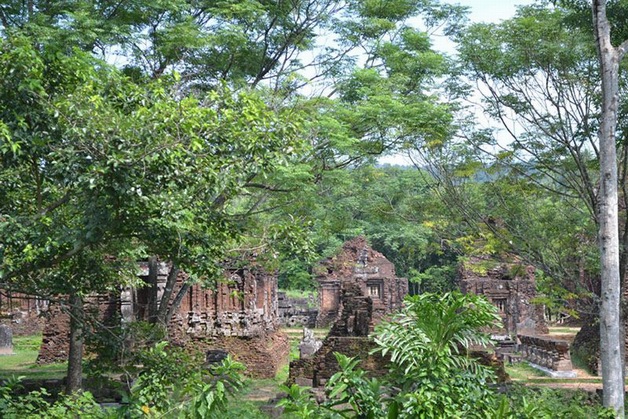My Son sanctuary

My
Son sanctuary is a cluster of abandoned and partially ruined Hindu temples
constructed between the 4th and the 14th century AD by the kings of Champa.
The temples are dedicated to the worship of the god Shiva, known under
various local names, the most important of which is Bhadreshvara.
My Son is located near the village of Duy Phu, district of Duy Xuyen in
Quang Nam Province in
Central Vietnam, 70km southwest of
Da Nang (45km from
Hoi An), and approximately 10km from the historic town of Tra Kieu. The
temples are in a valley roughly 2km wide that is surrounded by two mountain
ranges.
From the 4th to the 14th century AD, the valley at My Son was a site of
religious ceremony for kings of the ruling dynasties of Champa, as well as a
burial place for Cham royalty and national heroes. It was closely associated
with the nearby Cham cities of Indrapura (Đồng Dương) and Simhapura (Trà
Kiệu). At one time, the site encompassed over 70 temples as well as numerous
stele bearing historically important inscriptions in Sanskrit and Cham.
My Son holy land is perhaps the longest inhabited archaeological site in
Indochina, but a large majority of its architecture was destroyed by US
carpet bombing during a single week of the war.
The My Son temple complex is regarded one of the foremost Hindu temple
complexes in Southeast Asia and is the foremost heritage site of this nature
in Vietnam. It is often compared with other historical temple complexes in
Southeast Asia, such as Borobudur of Java in Indonesia, Angkor Wat of
Cambodia, Bagan of Myanmar and Ayutthaya of Thailand. As of 1999, My Son has
been recognized by UNESCO as a world heritage site. UNESCO accorded My Son
this recognition pursuant to its criterion C (II), as an example of
evolution and change in culture, and pursuant to its criterion C (III), as
evidence of an Asian civilization which is now extinct.
Types of buildings All of the remaining buildings at My Son are believed to
be religious buildings. They are of the following types:
- A kalan is a brick sanctuary, typically in the form of a tower, used to
house a deity.
- A mandapa is an entry hallway contiguous with a sanctuary.
- A kosagrha or “fire-house” is a construction, typically with a
saddle-shaped roof, used to house the valuables belonging to the deity or to
cook for the deity.
- A gopura is a gate-tower leading into a walled temple complex.
Most of the temples at My Son sanctuary were made of red brick, and only one
(the temple labelled “B1”) was made of stone. Even the decorative carvings
on the Cham temples were cut directly onto the bricks themselves, rather
than onto sandstone slabs inserted into brick walls as is observable for
example in the 9th century Cambodian temple of Bakong.
To this day, the construction techniques used by the Cham builders are not
completely understood. Issues that have not been completely resolved include
issues about the firing of the bricks, the mortar between the bricks, and
decorative carvings found on the bricks.
At what point in the building process were the bricks hardened by fire? Were
the bricks hardened first, and then arranged in order to build the
structures, or were the structures built out of partially hardened bricks,
after which the entire structures were heated by fire to finish the
hardening of the bricks? The hypothesis that the entire structures were
reheated following assembly is supported by evidence that the mortar between
the bricks was at some point subjected to high temperatures. The contrary
hypothesis is supported by the observation that the structures bear no signs
of scarring from large intense fires such as would be needed in order to
reheat them as whole.
How were the bricks stuck together? One hypothesis is that the builders at
My Son developed a way to glue bricks together using tree resin native to
central Vietnam. Another hypothesis is that the builders used a sticky
mortar made from the same clay as the bricks themselves. The latter
hypothesis is supported by chemical tests that have found no trace of any
organic substance between the bricks, but instead have found mineral
substances similar to those present in the core of the bricks. Today the
mortar that once held the bricks together has largely decayed, and even a
strong wind can knock loose bricks from the structures.
At what point in the process were the decorative carvings made? Were the
walls constructed and then carved, or were the bricks carved first and then
assembled so as to create the walls? An examination of the carvings reveals
no broken lines as would be expected if the bricks were carved first and
then assembled; and as a result scholars have concluded that the Cham
craftsmen made their carvings directly onto finished brick walls.
Visit to My Son relic, also you should not miss a performance of Cham
performing arts – Apsara dance. This is an intangible cultural activity that
is reproduced vividly in the My Son relic. Excerpts from Cham festivals,
court dance, and religious dance are staged to help those who come to My Son
to better appreciate the unique values of the culture and civilization of
Champa.





